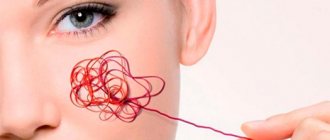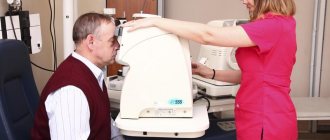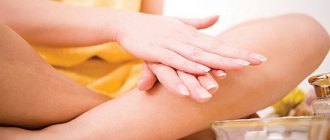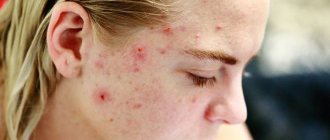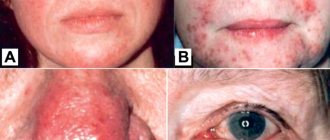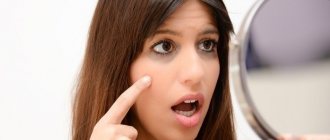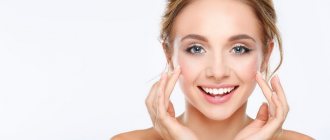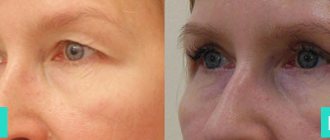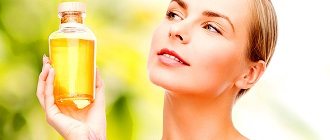Rosacea. Full Review and Treatment Options
What are spider veins?
This is a manifestation of rosacea and general redness of the skin.
But we need to fight them in different ways. If we can combat general redness of the face with cosmetics that prevent redness of the skin and soothe the skin (irritation). You can use medications that are used for rosacea; they are prescribed by dermatologists and cosmetologists to remove this exacerbation, reduce redness and put it into remission (a calm period of facial skin). Spider veins are a different story than facial redness, although these are still the same manifestations of rosacea. You can’t put cream on them to make them shrink, you can’t “stab” them with a mesopreparation to make them go away. Here it is necessary to use direct physical influence. With laser technologies, it is possible to locally remove (seal) microvessels with a narrowly directed beam of light.
Video about rosacea: You can’t cover up spider veins. How to delete?
A cosmetologist is considering different options for removing spider veins.
Contact a specialist and he will tell you exactly how to remove spider veins. Different clinics have different laser devices, and the disadvantage of a laser is that it can only remove small single vessels, bright stars.
But it’s impossible to remove the stars and all the redness on the face at the same time. Laser technology does not allow this. For this purpose, there is IPL intensive diffused light technology. This technology is called photorejuvenation differently, it has a different mechanism.
photorejuvenation
How does photorejuvenation work on blood vessels?
For rays of intense light, the pigment is the target. For example, during photoepilation it is hair pigment, and during photorejuvenation (when we work with blood vessels) it is blood pigment. How does it work? The intense light heats the hemoglobin in the blood vessel. The vessel is glued together and then replaced by connective tissue. A large area of the face is being treated, and therefore it is possible to treat the entire face and work with individual vessels at the wings of the nose and remove spider veins on the face. For rosacea, I myself prefer to work with IPL. Using this technique and procedures, I can do the maximum for a person who has rosacea, stars and redness.
How often should treatments be done for rosacea and how long is the effect?
procedures for rosacea
We cannot remove spider veins forever. We remember that rosacea is a constitutional feature of the body and we cannot be 100% sure that we have removed it and you will not have it again.
If we take a specific spider vein on your face or along the sides of the nose, then we can work on these areas three to four times in order to remove the vessels. Sometimes one procedure is enough, sometimes three or four procedures are needed with an interval of 3-5 weeks. It is necessary to carry out these procedures in the autumn-winter period, when the sun is active in the sky; it is undesirable to do this.
The effect lasts differently for everyone. In order for it to be maximum, it is necessary to follow all the cosmetologist’s prescriptions, including those regarding lifestyle. Do not use provocative situations with temperature fluctuations and do not consume products that provoke rosacea.
If you use special cosmetics, if you don’t go to the bathhouse or drink red wine, then the effect will last for the maximum period. Perhaps it will be a year, perhaps two years, then you will go through the whole 10 years without spider veins.
If you do not follow the recommendations of your cosmetologist, then be prepared for rosacea to return very quickly. And one more very important point: vascular manifestations at the wings of the nose and on the cheeks here they appear not just because there are some provocateurs. Patients come to me all the time, not even with blood vessels! And right with a red nose, with red cheeks only because they have been squeezing blackheads in this area for years and removing blockages on their own.
Remember, if you are prone to rosacea and have blood vessels, do not cleanse your face daily or weekly. All such traumatic procedures by a cosmetologist should be kept to a minimum.
- Cosmetologist Yuliana Shiyan
Diagnostics
The diagnosis, as recommended in medical textbooks and articles, is made based on the results of a physical examination of the visible manifestations of the disease and clarification of the medical history. The patient is asked in detail about the time of onset of primary symptoms. The doctor may ask about factors that, in the patient's opinion, reduce or increase symptoms. An additional research method, biopsy, is rarely used. This is the removal of a small piece of skin with a swab or scraping to identify parasites. In rare cases, monthly blood chemistry tests are performed for total bilirubin, serum alanine aminotransferase, aspartate aminotransferase, triglycerides, total cholesterol, glucose, serum creatinine, or alkaline phosphatase. Sometimes testing is done for antinuclear antibodies, which appear in the bloodstream as indicators of destruction of connective tissue cells. According to indications, seek advice from one of the specialists: an ophthalmologist, gastroenterologist, endocrinologist or psychotherapist.
An ophthalmologist is necessary if there is a risk of developing ocular rosacea. This specialist can prescribe supportive measures to alleviate the patient’s suffering: relieve the feeling of pain and dryness in the eyes, reduce sensitivity to bright light.
The gastroenterologist will prescribe additional diagnostic procedures to assess the condition of the digestive system. He can develop recommendations for proper nutrition or therapeutic fasting. It has been confirmed that smoked foods, saltiness, spices, citrus fruits, coffee-containing drinks, as well as alcohol increase the redness of the facial skin and provoke the appearance of new rashes.
An endocrinologist uses an examination to identify hormonal imbalances. Pathologies of the endocrine system often cause hot flashes. If unpleasant skin rashes appear, pre-prescribed hormonal therapy requires adjustment.
The psychotherapist will conduct a conversation to determine the general psycho-emotional state. He will advise what psychological techniques, relaxation techniques or sedatives can be used to get rid of depression. Patients suffering from rosacea, especially the severe form, often become more shy and withdrawn. Women usually hide imperfections with camouflage cosmetics, hide them behind long hair, and do not like to be seen. Females aged 30 to 40 years are at risk.
Causes of Rosacea
The exact causes of rosacea on the face, alas, have not been established, but the treatment is known and gives lasting results.
What are the provoking factors for the development of the disease?
- Vascular disorders
- Gastrointestinal diseases
- Endocrine system dysfunction
- Psychosomatic and immune disorders
- Frequent sudden changes in air temperature (therefore, symptoms of rosacea most often appear in residents of regions with frosty winters)
- Emotional stress causing redness of the skin
- Demodicosis
Couperosis, acne and rosacea are not the same thing, although the conditions may be similar in appearance! Only a doctor can determine the exact symptoms and treatment of rosacea on the face.
Table of contents
- Etiology and pathogenesis
- Clinical manifestations
- Hardware treatments for rosacea
Rosacea is a common condition characterized by facial flushing, telangiectasias, rough skin, and inflammatory papulopustular changes. Other names for this pathology: rosacea, acne rosacea, teleangiectasiasis faciei, couperose, gutta rosacea (from the French “goutterose” - “pink drop”) , pustule de vin (translation from French: “wine bubbles”). As you can see, the historical names of rosacea indicate the connection of this disease with the use of alcoholic beverages.
In our company you can purchase the following equipment for the treatment of rosacea:
- M22 (Lumenis)
It is estimated that rosacea affects up to 15% of fair-skinned Europeans. A study conducted in Sweden showed that this disease was recorded in 1 out of 10 middle-level workers (the so-called middle class). According to Russian dermatologists, rosacea accounts for about 5% of all dermatological diagnoses. At the same time, Russian cosmetologists believe that this figure is much higher - 20.6%.
The expert panel of the National Rosacea Society divides rosacea into 4 types:
- Erythematous-telangiectatic.
- Papulopustular.
- Phymatous.
- Ophthalmological.
The disease typically consists of a range of symptoms and signs, with many patients experiencing multiple types of rosacea.
Recommended Procedures
Phototherapy of rosacea - to eliminate dilated blood vessels and activate the growth of new healthy capillaries, stimulate skin renewal and suppress inflammation.
Ultrasound peeling is an atraumatic, delicate way to cleanse the skin of keratinized epidermis, impurities and excess sebum.
Mesotherapy with cocktails with active ingredients that strengthen blood vessels, reduce skin sensitivity, regulate the functioning of the sebaceous glands, and prevent the development of inflammation.
Biorevitalization to improve skin immunity
How to treat rosacea?
Rosacea is a chronic, non-infectious, progressive disease associated with inflammation of the blood vessels of the facial skin. Most often it occurs in people with very fair skin, type I-II according to Fitzpatrick (it is not for nothing that it is called “Celtic disease”), after 30 and reaches its peak in 40-50 years. In the early stages of rosacea, patients experience facial redness, a feeling of heat and flushing on the face. At later stages, telangiectasia, papules and pustules, and disruption of the sebaceous glands occur. In many cases, the course of rosacea is complicated by demodicosis - the pathological activity of the subcutaneous mite, which aggravates the inflammatory process.
Prevention
Along with treatment, preventative measures are also important. To prevent the development of rosacea, you need to avoid exposure to:
- sun and wind;
- unhealthy diet;
- harmful drinks;
- medicines;
- aggressive cosmetic procedures (peelings, surgical skin smoothing, rubbing, warming masks, etc.).
For prevention, specialists regularly prescribe short courses of antibiotics. It is recommended to constantly care for the skin with cosmetic products for gentle cleansing, moisturizing and protection from ultraviolet radiation (for sensitive skin). It is necessary to remember about the treatment of concomitant pathologies, especially diseases of the digestive tract. Getting rid of the consequences does not diminish the cause of the illness.
Stages of the disease and symptoms
Rosacea is characterized by alternating periods of exacerbation and remission. During periods of exacerbation, 3 main stages can be distinguished:
- Erythematotelangiectatic
. In the area of the cheeks, cheekbones and nose, small vessels, spider veins and red spots - erythema - appear. Their appearance is accompanied by burning and itching. - Papulopustular
. Swelling of the face appears, and large pink-red acne (papules) appear in the area of the cheekbones, forehead, nose and chin. A person may initially mistake them for an allergic reaction or regular acne. - Pustular nodular
. Erythema and papules spread throughout the face, papules merge with each other, and the skin becomes denser. The inflammation is not relieved and the swelling intensifies. Scars and depressions appear on the skin.
At all stages of the disease, there is a risk of ophthalmic rosacea - damage to the mucous membranes of the eyes due to the development of blepharitis, conjunctivitis, chalazion, keratitis, etc.
The disease should not be taken lightly. It is better to consult a doctor at the first stage in order to begin treatment before the consequences become irreversible.
